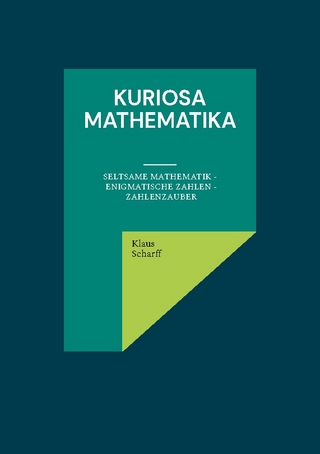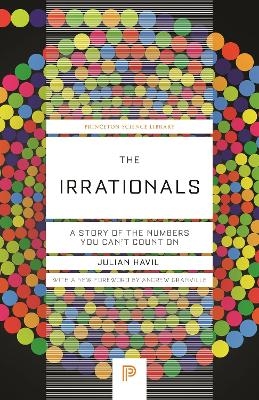
Representations of Integers as Sums of Squares
Springer-Verlag New York Inc.
978-0-387-96126-2 (ISBN)
- Titel ist leider vergriffen;
keine Neuauflage - Artikel merken
Indeed, about that time I had already started thinking about the possibility of such a book and had, in fact, quite precise ideas about the kind of book I wanted it to be.
1 Preliminaries.- 1. The Problems of Representations and Their Solutions.- 2. Methods.- 3. The Contents of This Book.- 4. References.- 5. Problems.- 6. Notation.- 2 Sums of Two Squares.- 1. The One Square Problem.- 2. The Two Squares Problem.- 3. Some Early Work.- 4. The Main Theorems.- 5. Proof of Theorem 2.- 6. Proof of Theorem 3.- 7. The "Circle Problem".- 8. The Determination of N2(x).- 9. Other Contributions to the Sum of Two Squares Problem.- 10. Problems.- 3 Triangular Numbers and the Representation of Integers as Sums of Four Squares.- 1. Sums of Three Squares.- 2. Three Squares, Four Squares, and Triangular Numbers.- 3. The Proof of Theorem 2.- 4. Main Result.- 5. Other Contributions.- 6. Proof of Theorem 4.- 7. Proof of Lemma 3.- 8. Sketch of Jacobi's Proof of Theorem 4.- 9. Problems.- 4 Representations as Sums of Three Squares.- 1. The First Theorem.- 2. Proof of Theorem 1, Part I.- 3. Early Results.- 4. Quadratic Forms.- 5. Some Needed Lemmas.- 6. Proof of Theorem 1, Part II.- 7. Examples.- 8. Gauss's Theorem.- 9. From Gauss to the Twentieth Century.- 10. The Main Theorem.- 11. Some Results from Number Theory.- 12. The Equivalence of Theorem 4 with Earlier Formulations.- 13. A Sketch of the Proof of (4.7?).- 14. Liouville's Method.- 15. The Average Order of r3(n) and the Number of Representable Integers.- 16. Problems.- 5 Legendre's Theorem.- 1. The Main Theorem and Early Results.- 2. Some Remarks and a Proof That the Conditions Are Necessary.- 3. The Hasse Principle.- 4. Proof of Sufficiency of the Conditions of Theorem 1.- 5. Problems.- 6 Representations of Integers as Sums of Nonvanishing Squares.- 1. Representations by k ? 4 Squares.- 2. Representations by k Nonvanishing Squares.- 3. Representations as Sums of Four Nonvanishing Squares.- 4. Representations as Sums of Two Nonvanishing Squares.- 5. Representations as Sums of Three Nonvanishing Squares.- 6. On the Number of Integers n ? x That Are Sums of k Nonvanishing Squares.- 7. Problems.- 7 The Problem of the Uniqueness of Essentially Distinct Representations.- 1. The Problem.- 2. Some Preliminary Remarks.- 3. The Case k = 4.- 4. The Case k ? 5.- 5. The Cases k = 1 and k = 2.- 6. The Case k = 3.- 7. Problems.- 8 Theta Functions.- 1. Introduction.- 2. Preliminaries.- 3. Poisson Summation and Lipschitz's Formula.- 4. The Theta Functions.- 5. The Zeros of the Theta Functions.- 6. Product Formulae.- 7. Some Elliptic Functions.- 8. Addition Formulae.- 9. Problems.- 9 Representations of Integers as Sums of an Even Number of Squares.- 1. A Sketch of the Method.- 2. Lambert Series.- 3. The Computation of the Powers ?32k.- 4. Representation of Powers of ?3 by Lambert Series.- 5. Expansions of Lambert Series into Divisor Functions.- 6. The Values of the rk(n) for Even k ? 12.- 7. The Size of rk(n) for Even k ? 8.- 8. An Auxilliary Lemma.- 9. Estimate of r10(n) and r12(n).- 10. An Alternative Approach.- 11. Problems.- 10 Various Results on Representations as Sums of Squares.- 1. Some Special, Older Results.- 2. More Recent Contributions.- 3. The Multiplicativity Problem.- 4. Problems.- 11 Preliminaries to the Circle Method and the Method of Modular Functions.- 1. Introduction.- 2. Farey Series.- 3. Gaussian Sums.- 4. The Modular Group and Its Subgroups.- 5. Modular Forms.- 6. Some Theorems.- 7. The Theta Functions as Modular Forais.- 8. Problems.- 12 The Circle Method.- 1. The Principle of the Method.- 2. The Evaluation of the Error Terms and Formula for rs(n).- 3. Evaluation of the Singular Series.- 4. Explicit Evaluation of L.- 5. Discussion of the Density of Representations.- 6. Other Approaches.- 7. Problems.- 13 Alternative Methods for Evaluating rs(n).- 1. Estermann's Proof.- 2. Sketch of the Proof by Modular Functions.- 3. The Function ?s(?).- 4. The Expansion of ?s(?) at the Cusp ? = -1.- 5. The Function ?s(?).- 6. Proof of Theorem 4.- 7. Modular Functions and the Number of Representations by Quadratic Forms.- 8. Problems.- 14 Recent Work.- 1. Introduction.- 2. Notation and Definitions.- 3. The Representation of Totally Positive Algebraic Integers as Sums of Squares.- 4. Some Special Results.- 5. The Circle Problem in Algebraic Number Fields.- 6. Hilbert's 17th Problem.- 7. The Work of Artin.- 8. From Artin to Pfister.- 9. The Work of Pfister and Related Work.- 10. Some Comments and Additions.- 11. Hilbert's 11th Problem.- 12. The Classification Problem and Related Topics.- 13. Quadratic Forms Over ?p.- 14. The Hasse Principle.- Appendix Open Problems.- References.- Addenda.- Author Index.
| Zusatzinfo | biography |
|---|---|
| Verlagsort | New York, NY |
| Sprache | englisch |
| Gewicht | 535 g |
| Themenwelt | Mathematik / Informatik ► Mathematik ► Arithmetik / Zahlentheorie |
| Mathematik / Informatik ► Mathematik ► Wahrscheinlichkeit / Kombinatorik | |
| ISBN-10 | 0-387-96126-7 / 0387961267 |
| ISBN-13 | 978-0-387-96126-2 / 9780387961262 |
| Zustand | Neuware |
| Informationen gemäß Produktsicherheitsverordnung (GPSR) | |
| Haben Sie eine Frage zum Produkt? |
aus dem Bereich


